I have
proposed
that a significant proportion of pitchers' elbow and shoulder injuries are due
to a set of mechanical flaws that I individually refer to as the
Inverted W,
Inverted V, and
Inverted L and
collectively refer to as the inverted arm actions. I go into
the details of these mechanical flaws in the pieces linked to
above. In this
article I go over the history of the Inverted W, propose a theory of why those
mechanical flaws may cause problems, and go over the literature and
its relevance to my theory.
The Science Behind the Inverted W: A Review of the Literature
Pitching coaches and their pupils have long discussed and
dealt with timing problems.
In the pitching vernacular, timing problems generally
fall under the umbrella of "rushing."
When rushing, the pitching arm is late; the
Pitching Arm Side (PAS) forearm isn't in the correct position at the
moment the front, or Glove Side (GS), heel plants and the
shoulders start rotating.
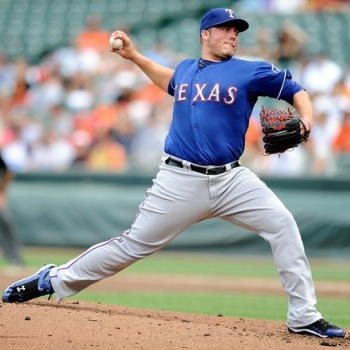
Tommy Hunter Rushing

Stephen Strasburg Rushing
In the photos above, notice how the pitchers' front heels
have planted but their PAS forearms, instead of being close to
vertical, instead are much closer to horizontal. That is
because, instead of being at 90 degrees of external rotation,
their PAS upper arms are at just 10 or so degrees of external
rotation.
The Down Side of Rushing
Pitching coaches have long known that a problem with rushing
can create a tendency to leave the ball up in the strike zone.
However, I believe that, if done habitually, a problem with
rushing can increase the load on the elbow and/or the shoulder
by causing the PAS upper arm to externally rotate more, and
more forcefully, than is typical. That can increase the load
on the elbow and shoulder and cause them to break down
prematurely.
The Up Side of Rushing
It has long been recognized that rushing can have negative
performance implications. However, over the past ten to
fifteen years some pitching instructors — and Paul Nyman in
particular — have come to believe that rushing, despite the
problems is may cause, may also allow a pitcher to throw the
ball harder than they can when using more conventional
mechanics. That is because rushing can more effectively load
the muscles of the shoulder and torso and increase their power
output.[1]
The proliferation of the Inverted W
The belief that there is an upside to rushing is
based on studying the arm actions of some of the
hardest-throwing pitchers and, in particular, their scapular
loading. Pitchers whose arm actions were studied and
copied include John Smoltz, Billy Wagner, and Joel Zumaya.

John Smoltz's Inverted W
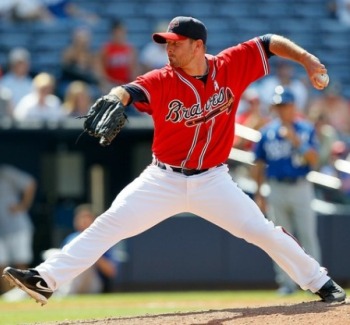
Billy Wagner's Inverted V
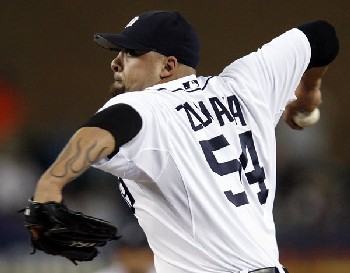
Joel Zumaya's Inverted V
While the pitchers above likely came up with their arm
actions on their own, and stuck with those arm actions due to their
effectiveness, pitching instructors like Paul Nyman then developed a set
of cues, the most prominent of which is to "Break the hands
with the elbows," that can increase the likelihood that
the pitcher will develop and inverted arm action and provide
them with a velocity boost.[2] Those cues were then used to
mold the arm actions of pitchers like Mark Prior and Anthony Reyes.
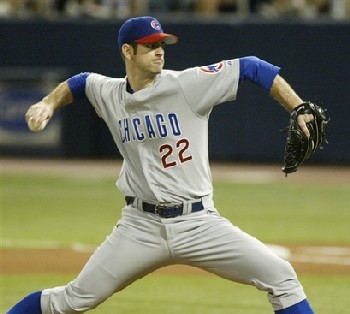
Mark Prior's Inverted W
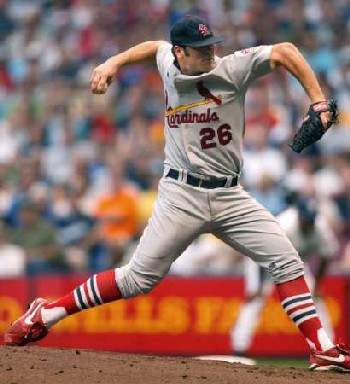
Anthony Reyes' Inverted W
Brandon McCarthy and others saw the success of pitchers
like Mark Prior and decided to emulate the Inverted W arm
action.

Brandon McCarthy's Inverted W
What the Studies Say
There are a number of published studies that bear
some relevance to this topic.
Early Cocking Phase Mechanics
As I discuss at length in my new
Inverted W webbook, the
most recent, and definitive, study of the Inverted W is
Dr. Weimi
Douoguih's 2012 paper on Early Cocking Phase Mechanics.
Pitching Biomechanics Associated with Elbow
or Shoulder
Pain in Youth Baseball Pitchers
Dr. Cynthia LaBella recently presented a
study to the AAOS
that very directly relates to the topics I discuss, and in
particular to the problem with the Inverted W, Inverted L, and
Inverted V. The most relevant lines are these...
Paired t-tests compared the pain group to
the no-pain group for the following three variables that had
the greatest difference in mean scores between groups:
- Internal shoulder rotation at initiation of external
shoulder rotation in stride.
- Shoulder elevation at initiation of elbow extension in
stride.
- Average shoulder elevation from start of pitching
cycle to time of maximum shoulder elevation.
...The pain group had greater
internal shoulder rotation at the initiation of external
rotation in the stride.
When LaBella talks about internal rotation and delayed
external rotation, she is talking about timing problems that
relate to the inverted arm actions. The inverted arm actions
create more internal rotation and delay the onset of external
rotation, and LaBella's study indicates that prolonged internal
rotation increases the likelihood that pitchers will experience
problems.
Correlation of Throwing Mechanics With Elbow Valgus Load in Adult Baseball Pitchers
The study starts off with this hypothesis.
Hypothesis: The onset of trunk rotation, with
other biomechanical variables that define sequential body
motion, will significantly predict elbow valgus loading.
In other words, their hypothesis is that elbow valgus loading, which is
a specific type of force on the elbow that leads to the need for TJ surgery, is related to a
pitcher's timing (aka the onset of trunk rotation). This is
relevant because the Inverted W can change the timing of the
movements of the pitcher's arm relative to the onset of trunk rotation.
That in turn can changes the amount of stress on the elbow
(and IMO the shoulder). In other
words...
- Good timing = Pitching Arm Side (PAS) forearm
vertical and at 90 degrees of external rotation when trunk
rotation starts which means less forceful external rotation
which means less Valgus stress.
- Bad timing = PAS forearm not vertical and at much less
than 90 degrees of external rotation when trunk
rotation starts which means more forceful external rotation
which means More
valgus stress.
The results of the study included...
Results: Players who initiated trunk rotation
before front-foot contact had significantly higher elbow
valgus torques than did those who rotated afterward (P =
.02).
In other words, players who had major timing problems were
more vulnerable to elbow problems. That doesn't say anything
about the Inverted W per se, but it does say there's a
relationship between timing problems and the stress on the
elbow.
In the case above, the
problem is that the pitcher starts rotating their shoulders too
early, likely before their arm is up and in the correct
position. The Inverted W does the same
thing; it delays the arm in getting up into the correct
position and makes it late.
Results: Reduced elbow valgus torques were
associated with increased elbow flexion (P = .01)...Similarly, a higher elbow flexion angle at the
instant of peak elbow valgus was associated with reduced
magnitudes of elbow valgus torque.
So bending/flexing the elbow helps to protect it. This is
probably related to why
Mark Prior, for all of his problems, never needed Tommy
John surgery. It could also explain the lack of elbow problems
in short-armers like Greg Maddux and Roger Clemens.
Although there were no significant differences in
demographics or ball velocity between groups (P = .10),
the pre-foot contact players exhibited significantly more
elbow valgus torque (59 ± 27 Nm) than the post-foot
contact players did (42 ± 29 Nm, P = .02) (Figure 5).
So, again, timing matters in terms of the load on the
elbow.
Fourteen pitchers displayed a sidearm delivery,
exhibiting an average elbow valgus torque of 66 ± 24 Nm,
which was significantly higher (P = .02) than that of
those who threw with the more common overhand, or "3/4,"
slot position (46 ± 29 Nm) (Figure 6).
This is VERY interesting. Lots of pitching coaches think
throwing sidearm is worse for the arm than throwing from a
higher arm slot. I've pooh-poohed the idea that throwing
sidearm is bad because I've never seen
a study back up that notion.
Until now.
Pitchers who rotated their trunks (ie, squared up)
later in the pitching cycle appeared to have reduced
magnitudes of elbow valgus torque.
I believe that this is because it gives the arm more time
to get more vertical. However, the Inverted W interferes with
this process and causes the arm to get up late.
In this study, pitchers who initiated trunk rotation
before front-foot contact exhibited significantly more
elbow valgus torque than did those who rotated their
trunks afterward.
In other words, and again, pitchers who start rotating their shoulders
before their Pitching Arm Side forearms are up and at 90
degrees of external rotation — which is what happens during the
Inverted W — are more vulnerable to elbow problems.
This study only indirectly talks about the
Inverted W, but it helps to bolster my case. This case
demonstrates that timing problems increase the load on the
elbow. Since the Inverted W can create a timing problem, it
can increase the load on the elbow.
Correlation of Torque and Elbow Injury in
Professional Baseball Pitchers
One basis of the theory that the Inverted W is
related to shoulder and elbow problems is the idea that the
Inverted W causes a timing problem and that that timing
problem increases the load on the elbow and the shoulder by
delaying and increasing the amount of external rotation of the
Pitching Arm Side upper arm. This study provides evidence that
increased levels of load on the elbow and shoulder are
problematic.
Pitchers experiencing higher
levels of elbow valgus torque and shoulder external rotation
torque throughout the pitching motion are more likely to
suffer elbow injury than pitchers with lower levels of torque.
This study also notes that there is an established relationship
between pitching mechanics and the load on the elbow and the
shoulder.
Subtle differences in mechanics (e.g.,
onset of trunk rotation, maximal shoulder external
rotation, elbow flexion at ball release) have been shown
to produce differences in the torques and forces
experienced at the elbow and shoulder throughout the
pitching motion.
Notes
[1] I explain how I noticed the link between the Inverted
W, rushing, and injury problems in my
Inverted W FAQ.
[2] The Inverted W is the moral
equivalent of running a car engine past the red line. It
works. For a while.